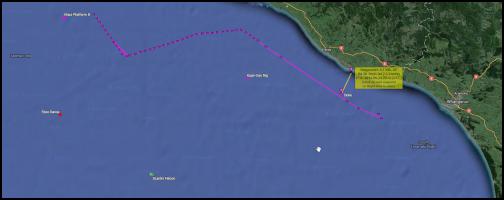Oil Exploration in Maui Dolphin Protection Zone

Click for big version.
Released Map Show Oil Exploration in Maui Dolphin Protection Zone Last Week
A map released today tracks the route of oil exploration ship Duke just off the coast of Patea and Whanganui which runs over Maui’s dolphin habitat, and the protected area for Maui’s Dolphin recommended by the International Whaling Commission last month. Dr Liz Slooten, an Otago University expert in whales, dolphins and porpoises, says the map clearly shows oil exploration breaching the protected area for Maui’s dolphin that has strong public support from all around the country and from New Zealand and international scientists.
Dr Slooten says Conservation Minister Dr Nick Smith is wrong about Maui dolphins not being in the oil survey zones (1). “The Scientific Committee of the International Whaling Commission has urged New Zealand to protect Maui’s dolphins out to 20 nautical miles offshore from Maunganui Bluff in the north to Whanganui in the south. These oil surveys put the world’s smallest dolphin at further risk by covering more than half of the protected area recommended by the IWC. This could literally be the last nail in the coffin for Maui’s dolphin”.
Oil exploration ship Duke has been commissioned by Todd Shell. It has a long tail that trails behind the ship with detonators which sends a sonic explosion that penetrates the seabed and bounce back to the ship. This seismic testing reveals geologies below the seabed which may point to where oil and gas are located.
Dr Slooten says that having observers on oil survey vessels are “virtually useless” and do very little to protect whales.
“Overseas research has shown that observers on the seismic testing ships only see around ten percent of whales and dolphins in the area. That’s because sperm whales, for example, spend 45 minutes diving and feeding for every 10 minutes they comes to the surface to breathe.”
“Most of the whales that are sensitive to noise will be on the run or already be in deep trouble, before the observers can see them”, said Dr Slooten. “Seismic survey noise can be heard for at least 80 kilometres, but the observers can see whales and dolphins for only one or two kilometres, and then, only when they surface.”
“Beaked and sperm whales are sensitive to seismic sonar explosions for oil exploration that can damage hearing, whichwhales rely on to navigate, and they can be killed, if they’re very close to the sonic explosions”.
About half of the
world’s whales, dolphin and porpoise species live in our
waters. They often travel huge distances around our country
at different times of the year.
Dr Liz Slooten says
there are three common responses from when whales are scared
by sonar:
1) a reaction to escape the sounds can push
marine mammals into areas of other risks (eg netting)
2)
because sound travels further in deep water, whales may head
for shallower and shallower water where the sonar noise
becomes quiet more quickly, and end up beaching
themselves
3) beaked whales normally feed 1000-3000
deep off Northland and may panic and try to surface too
quickly. This can give them the bends by not being able to
depressurise. The result is death.
A rare pygmy sperm whale beached earlier this year near Raglan while seismic testing was going on for oil and gas. The cause of death is unknown because the whale was quickly shot and buried before an autopsy could be carried out.
(1) http://www.stuff.co.nz/national/politics/10193354/Nick-Smith-backtracks-over-Mauis-Dolphin
ends


 Gordon Campbell: On The New Pope, And The Israeli Attack On Peter Davis
Gordon Campbell: On The New Pope, And The Israeli Attack On Peter Davis Water New Zealand: Stormwater 2025 - Tackling Flooding And Storms To Build A Climate-Resilient Future
Water New Zealand: Stormwater 2025 - Tackling Flooding And Storms To Build A Climate-Resilient Future New Zealand Labour Party: Labour Asks Why Govt Is Silent On Gaza
New Zealand Labour Party: Labour Asks Why Govt Is Silent On Gaza Transport Accident Investigation Commission: Near-Collision Highlights Safety Lessons For All Busy, Unattended Aerodromes
Transport Accident Investigation Commission: Near-Collision Highlights Safety Lessons For All Busy, Unattended Aerodromes Green Party: Wildlife Law Change A Deep Betrayal Of Public Trust
Green Party: Wildlife Law Change A Deep Betrayal Of Public Trust NZCTU: Unions Launch Petition To Protect Pay Equity
NZCTU: Unions Launch Petition To Protect Pay Equity Greenpeace: Greenpeace Slams PM’s Science Pick - 'Polluters Are Running The Show'
Greenpeace: Greenpeace Slams PM’s Science Pick - 'Polluters Are Running The Show'


